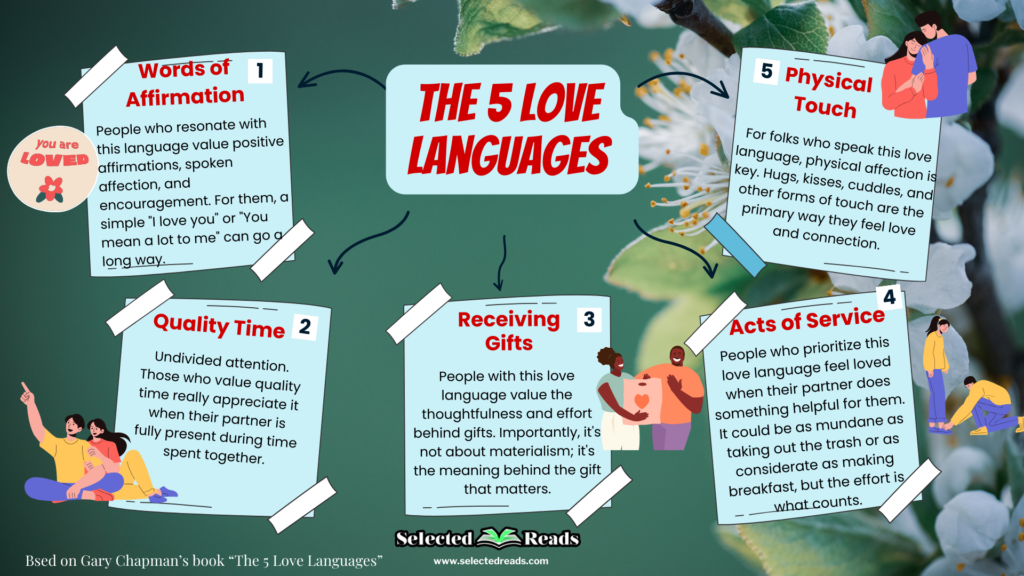Switching gears a bit, let’s talk relationships. You know, that complex puzzle even us seasoned educators sometimes struggle with off the clock. Today’s focus is on “The 5 Love Languages for Men” by Gary Chapman with Randy Southern. The book isn’t new to the relationship advice scene, but this version specifically targets men, offering a fresh angle to enhance relationships.
This exploration isn’t just a mere summary; it’s a journey through the intricate corridors of emotional communication as outlined by Chapman. We’ll dissect the book, critically analyzing its contents, and then, for those of you in book clubs or just looking for deeper reflection, I’ll offer some thought-provoking discussion questions. And if you’re hungry for more, don’t forget to check out my other post titled “20 of The Best 5 Love Languages Quotes” for some memorable snippets from the book.
What are The 5 Love Languages for Men?
Gary Chapman’s concept of the “Five Love Languages” is a framework that outlines how people tend to express and receive love. These languages aim to help people better understand their partners and strengthen their relationships. Here are the five men love languages according to Chapman:
- Words of Affirmation: This love language involves verbal acknowledgment and compliments. People who resonate with this language value positive affirmations, spoken affection, and encouragement. For them, a simple “I love you” or “You mean a lot to me” can go a long way.
- Quality Time: This love language is all about undivided attention. Those who value quality time really appreciate it when their partner is fully present during time spent together. Whether it’s a long walk or a deep conversation over coffee, the emphasis is on fully focusing on each other.
- Receiving Gifts: People with this love language value the thoughtfulness and effort behind gifts. Importantly, it’s not about materialism; it’s the meaning behind the gift that matters. Even small tokens can make a significant impact on someone who speaks this language.
- Acts of Service: In this category, actions speak louder than words. People who prioritize this love language feel loved when their partner does something helpful for them. It could be as mundane as taking out the trash or as considerate as making breakfast, but the effort is what counts.
- Physical Touch: For folks who speak this love language, physical affection is key. Hugs, kisses, cuddles, and other forms of touch are the primary way they feel love and connection. This extends beyond sexual touch; even a pat on the back or a squeeze of the hand can be deeply meaningful.
The 5 Love Languages Book Summary
Chapman central thesis is quite compelling: the way we express and experience love can be categorized into five distinct languages. These are Words of Affirmation, Acts of Service, Receiving Gifts, Quality Time, and Physical Touch. The book emphasizes that each individual has a primary love language, one that speaks to them more profoundly than the others. For a relationship to flourish, it’s crucial to understand not just your own love language, but more importantly, that of your partner.
In the male-centric version of his widely acclaimed work, the author speaks directly to men, addressing a common yearning: to master what truly matters in a relationship. The book isn’t just about understanding love languages; it’s a guide to applying this understanding to make a good relationship great. Chapman don’t just theorize; they provide practical tips and scenarios, making the content highly relatable and actionable. There’s a blend of humor and seriousness, a balance that keeps the reader engaged while driving home important points.
One of the key takeaways from the book is the idea of the “sweet spot” in love – when you express love in the language your partner understands best, it’s like hitting a home run. This analogy resonates particularly well with me, as it simplifies a complex emotional process into something tangible and understandable.
As an educational researcher and former teacher, I find the concept of love languages particularly interesting because it mirrors the principles of effective communication and tailored instruction. Just as we adapt our teaching methods to suit different learning styles, we must also adapt our emotional expressions to suit our partner’s love language. It’s about understanding and respecting individual differences in emotional needs and expressions.
Overall, in the men’s edition of the book, Chapman and Southern have done a commendable job in breaking down complex emotional interactions into understandable, relatable concepts. This book encourages men to step up their relationship game, not by grand gestures, but through understanding and speaking their partner’s love language fluently. For anyone looking to enhance their relationship, or simply to gain a deeper understanding of interpersonal dynamics, this book is a goldmine.
Critique of the book
While “The 5 Love Languages for Men” offers a compelling framework for understanding how different people express and receive love, it’s not without its critics or limitations. Here’s my take:
The Simplification Quandary
One of the biggest critiques is that Chapman and Southern simplify a very complex emotion into five neat categories. Love, as we all know, is a maze of complexities, influenced by factors like upbringing, past experiences, culture, and even current mood.
Lack of Scientific Backing
While Chapman and Southern’s book is widely popular, some psychologists argue that the empirical evidence behind the Five Love Languages is lacking. Despite anecdotes and testimonies, there’s a call for more rigorous, peer-reviewed research to back the claims.
Gender Norms and Stereotypes
The book sometimes leans into traditional gender roles, which can feel a bit dated or exclusive. In today’s landscape where we’re gradually moving towards a more inclusive understanding of gender and relationships, the book could be critiqued for not being as progressive. It assumes a heteronormative, binary framework that may not resonate with everyone.
Individualistic Approach
Chapman’s theory puts the onus on the individual to discover and cater to their partner’s love language. While individual efforts are essential in a relationship, this focus somewhat ignores systemic or external factors that contribute to relationship issues, such as work stress, health issues, or social pressures. In education, for example, we know that a child’s performance isn’t solely based on the teacher’s competence; factors like home environment, learning resources, and psychological well-being play a significant role.
The Commercial Aspect
Let’s not overlook the fact that the “5 Love Languages” concept has turned into a brand, complete with multiple book editions, workshops, and merchandise. While this doesn’t necessarily devalue the content, it does raise questions about commercial intentions versus genuine advice. The more popular a theory becomes, the more scrutiny it should withstand, right?
My Take
Overall, I appreciate the Five Love Languages for Men for the conversations it sparks. It’s a useful tool for people, especially men who may not have thought deeply about how they express or receive love. However, like any model or theory, it has its limitations. It’s a good starting point but should be complemented by a broader understanding of relationship dynamics, including advice from relationship experts and, in some cases, professional therapy.
Final thoughts
Whether in the context of romantic relationships, familial bonds, or professional connections, understanding the concept of love languages is a tool of invaluable worth. While the book is specifically tailored for men, its core message transcends gender, urging a deeper empathy and understanding in all forms of relationships. I invite you to reflect on how these insights can not only enhance your personal relationships but also enrich your approach to teaching and connecting with others.







